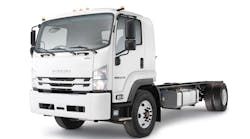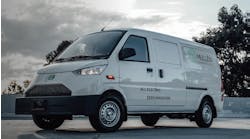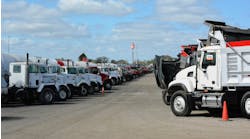While new-truck sales remain at elevated levels, fleets appear to be making a shift toward smaller vehicles and engines.
“Class 8 trucks with 12.0L to 14.0L engines are expected to surpass the 14.0L category for the first time ever in 2019,” said Kenny Vieth, president of ACT Research. He also said the straight truck segment is projected to continue to grow as more fleets order vehicles beyond the more traditional tractor-trailer combination.
Fuel economy is a key reason why there are more orders for vehicles with a lower gross vehicle weight (GVW).
“Smaller displacement engines have a higher power-to-density ratio along with a higher volumetric efficiency, which allows increased payload with comparable performance and greater fuel efficiency,” said John Moore, product marketing manager at Volvo Trucks North America.
However, Brian Daniels, manager of Detroit powertrain and component product marketing, said there has not yet been a major shift to the DD13 from the larger DD15. He explained the company’s technical sales experts work with customers to make sure they have the right solution for the job. They find the DD13 tends to be the best fit in regional applications, while the DD15 leads the long haul segments where fuel economy and performance are most important.
Similarly, Andrea Best, product manager at Cummins, said the company “continues to see success with its B6.7 and L9 engine platforms. In fact, 2018 registration data shows an uptick in larger displacement engines, such as Cummins’ L9 engine.”
In Volvo’s case, making its transmission a 12-speed with relatively close ratios removed concerns about fuel waste due to running at too high revolutions per minute after the downshift. Downshifting at as low as 1,000 rpm and employing a closer ratio split kept the engine very close to the sweet spot, Moore said.
“Moreover, Volvo avoided power complaints by reprogramming the [engine control module] so the engine torque would remain at peak levels down to 1,000 rpm. Previously, the lower limit had been 1,100 rpm.”
The goal of downspeeding is to save fuel. Each 100-rpm reduction saves 1% of the fuel bill, an estimated $730 per year.
Engines operate best when running slowly because a slower running engine reduces friction and parasitic losses, such as driving the water and oil pumps. Because the engine then runs under more load, it effectively becomes “smaller.” This means less air needs to be ingested, less exhaust needs to be forced out, and the fuel and air in the cylinder get hotter and develop more pressure on the power stroke.
Estimates as to the amount of fuel saved hover at the 2% to 3% range.
Dominik Beckman, director of marketing and dealer operations for Hino Trucks, said there are reasons beyond sticker price why customers may choose smaller displacement engines. However, he cautioned operating conditions, payload capacity, and other factors are important to take into consideration before making a choice.
“Smaller displacement engines typically have fewer parts and are less expensive to replace and/or repair than higher displacement engines. The performance gained from a higher displacement engine may not be needed for the tasks performed by the truck, making the investment unnecessary. Also, a tax benefit could be a consideration if choosing a smaller displacement engine to avoid stepping up to Class 8 and the 12% excise tax,” he said.
Meanwhile, in the medium-duty truck market, gasoline engines are gaining some popularity. That is especially true in the Class 5 segment, where V8 and V10 gasoline engines are increasing in popularity. However, in the larger Classes 6-7 markets, 6-cyl. diesel engines remain the preferred configuration.
“In our medium-duty segment, the DD5 and DD8 are smaller displacement engines than the previous leading engines in the segment and were designed with the latest technology,” Daniels said. “We are able to get the same levels of power ratings while reducing the amount of fuel used, which means there is less exhaust that the aftertreatment has to work to clean.
“We use a simple fixed geometry turbocharger to deliver reliability and responsiveness that surpasses some of the larger engines in the medium-duty segment,” he continued.
And while fleets sort out different diesel engine options, there are a growing number of new options available.
“Alternative power is being developed, tested, and refined, while diesel engines are also undergoing transition to become more fuel-efficient and clean,” said ACT’s Vieth.
Recent electric truck introductions by both established manufacturers and newer entrants support that idea.
Volvo’s Moore notes that electric trucks provide a path to a lower carbon footprint as urban areas strive for sustainable urban development.
Although the upfront cost of electric trucks is higher than diesel trucks, they potentially allow significant savings in fuel and maintenance costs.
Since most electric trucks are driven by battery-powered systems, however, battery expenses could be a determining factor whether fleets turn to these vehicles in the future.




